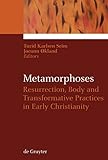Metamorphoses : Resurrection, Body and Transformative Practices in Early Christianity / ed. by Turid Karlsen Seim, Jorunn Økland.
Material type: TextSeries: Ekstasis: Religious Experience from Antiquity to the Middle Ages ; 1Publisher: Berlin ; Boston : De Gruyter, [2009]Copyright date: ©2009Description: 1 online resource (401 p.)Content type:
TextSeries: Ekstasis: Religious Experience from Antiquity to the Middle Ages ; 1Publisher: Berlin ; Boston : De Gruyter, [2009]Copyright date: ©2009Description: 1 online resource (401 p.)Content type: - 9783110202984
- 9783110202991
- Change -- Religious aspects -- Christianity -- History of doctrines -- Early church, ca. 30-600
- Human body -- Religious aspects -- Christianity -- History of doctrines -- Early church, ca. 30-600
- Alte Kirche
- Judentum
- Transformation
- RELIGION / Christian Theology / History
- Early Christianity
- Judaism
- Resurrection
- Transformation
- 230.11 22/ger
- BT743 .M46 2009
- online - DeGruyter
- Issued also in print.
| Item type | Current library | Call number | URL | Status | Notes | Barcode | |
|---|---|---|---|---|---|---|---|
 eBook
eBook
|
Biblioteca "Angelicum" Pont. Univ. S.Tommaso d'Aquino Nuvola online | online - DeGruyter (Browse shelf(Opens below)) | Online access | Not for loan (Accesso limitato) | Accesso per gli utenti autorizzati / Access for authorized users | (dgr)9783110202991 |
Frontmatter -- Contents -- Introduction -- The Resurrected Body in Luke-Acts: The Significance of Space -- Ancient Notions of Transferal and Apotheosis in Relation to the Empty Tomb Story in Mark -- “In your midst as a child” – “In the form of an old man” Images of Aging and Immortality in Ancient Christianity -- Genealogies of the Self: Materiality, Personal Identity, and the Body in Paul’s Letters to the Corinthians -- “With What Kind of Body Will They Come?” Metamorphosis and the Concept of Change: From Platonic Thinking to Paul´s Notion of the Resurrection of the Dead -- Complete and Incomplete Transformation in Paul – a Philosophical Reading of Paul on Body and Spirit -- “Flesh and Blood Cannot Inherit the Kingdom of God:” The Transformation of the Flesh in the Early Christian Debates Concerning Resurrection -- Valentinian Ideas About Salvation as Transformation -- “These are the Symbols and Likenesses of the Resurrection”: Conceptualizations of Death and Transformation in the Treatise on the Resurrection (NHC I,4) -- Metamorphosis and Mind Cognitive Explorations of the Grotesque in Early Christian Literature -- Male Women Martyrs: The Function of Gender-Transformation Language in Early Christian Martyrdom Accounts -- Imagining Human Transformation in the Context of Invisible Powers: Instrumental Agency in Second-Century Treatments of Conversion -- “As Already Translated to the Kingdom While Still in the Body” The Transformation of the Ascetic in Early Egyptian Monasticism -- The Angelic Life -- Recognizing the Righteous Remnant? Resurrection, Recognition and Eschatological Reversals in 2 Baruch 47-52 -- Backmatter
restricted access online access with authorization star
http://purl.org/coar/access_right/c_16ec
How were ideas and experiences of transformation expressed in early Christianity and early Judaism? This volume explores the social and philosophical frameworks within which transformative ideas such as resurrection and practices of becoming “a new being” were shaped. It also explores the analogies and parameters by which transformation was being observed, noted and asserted. The focus on transformation helps to connect topics that tend to be studied separately, such as cosmology, resurrection, aging, gender, and conversion. The textual material is wide-ranging and there are new readings of core passages. Ideas and experiences of transformations in early Christianity and early Judaism Connects topics that tend to be studied seperately (cosmology, resurrection, aging, gender, conversion) With wide-ranging textual material
Issued also in print.
Mode of access: Internet via World Wide Web.
In English.
Description based on online resource; title from PDF title page (publisher's Web site, viewed 28. Feb 2023)


